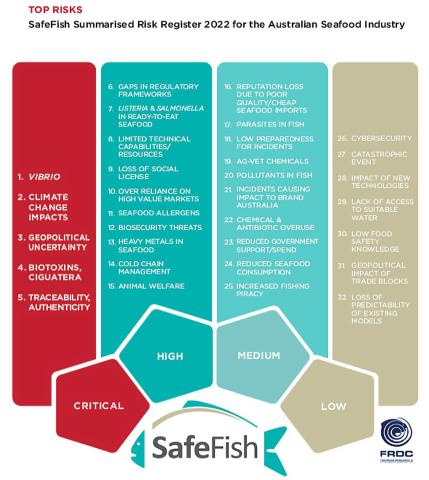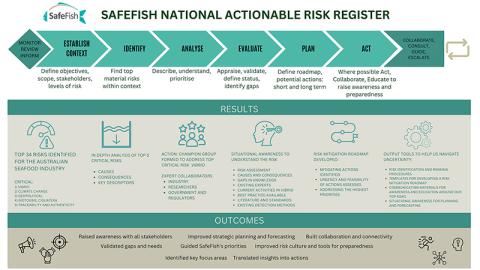By Dr Cristina Lesseur, Dr Alison Turnbull and Natalie Dowsett, SafeFish
A program of work run by SafeFish and funded by the FRDC has been specifically designed to increase awareness of food safety and build resilience for the Australian seafood industry.
SafeFish has begun to develop an actionable risk register (ARR) to help Australian seafood sectors identify and manage their most relevant risks in an effective and proactive way. The program aims to build a simple, actionable framework and develop a set of tools that can serve as a compass for industry to navigate through uncertainty.
The initial phase identified the top material risks at a national seafood level. Insights were gathered from industry and experts in research, regulation, food safety and key areas of concern such as crisis management, geopolitical, and general food industry practices. Participation was well balanced between sectors and supply chain representatives, allowing them to clearly understand the areas that needed attention and preparedness.
Thirty-two risks were identified and ranked into critical, high, medium and low categories.
Figure 1- Top material food safety and trade and market access risks of the Australian seafood industry

See enlarged view of the register
The most critical risks involve Vibrio, climate change, geopolitical uncertainty, biotoxins (Ciguatera), along with traceability and authenticity.
SafeFish Executive Officer, Natalie Dowsett, talked about the insights her team found.
“The key word was actionable. The insights and teamwork will become much more valuable when they are translated into material outcomes such as risk mitigating actions, roadmaps, and guidance tools.”
“With this in mind, SafeFish created a diverse team to help action our top critical risk – Vibrio” Natalie states.
Vibrio bacteria are a family of bacteria that live in warm sea water and can potentially contaminate seafood – with oysters and shellfish frequently falling victim.
The team has built a roadmap of the existing knowledge and priorities and is getting organised to deliver the most urgent and feasible actions to mitigate risk and fill the gaps.

See enlarged view of the process
The lessons learned at a national level have also set SafeFish up for delivering tools that can be applied to each seafood sector.
Natalie talked further about how the best results come when the risks are owned and addressed by not one or two – but all stakeholders.
“SafeFish will continue to provide the right tools for the job and help create a common ground to align collective efforts, along with developing a safe place for all sectors to share and work together in a pre-competitive space.” Natalie says.
“We’re supporting the Australian seafood industry to grow and build resilience for the future, along with proactively facing their food safety and market access challenges.”
Get involved – Safe fish is continuing processes that target risks specific to each seafood sector but needs support and engagement from stakeholders to do so. If you are interested in assisting, please contact the SafeFish secretariat.
More information
SafeFish secretariat: info@safefish.com.au or Dr Cristina Lesseur: advisory@cristinalesseur.com
This reflects R&D Plan Outcomes 2, 3 and 4





